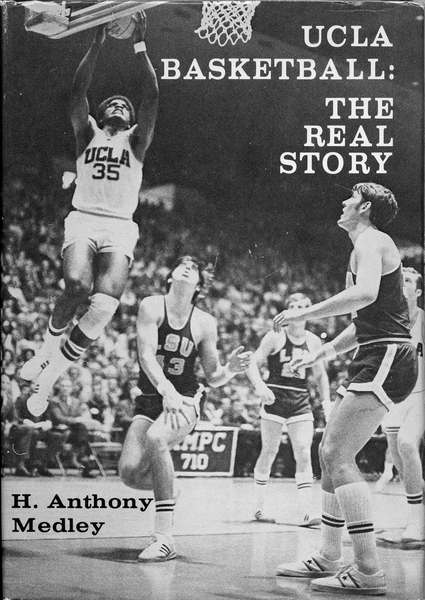|
Out of print for more than 30 years, now available for the first time as an eBook, this is the controversial story of John Wooden's first 25 years and first 8 NCAA Championships as UCLA Head Basketball Coach. This is the only book that gives a true picture of the character of John Wooden and the influence of his assistant, Jerry Norman, whose contributions Wooden ignored and tried to bury. Compiled with more than 40 hours of interviews with Coach Wooden, learn about the man behind the coach. The players tell their stories in their own words. Click the book to read the first chapter and for ordering information. Also available on Kindle. |
|
Sports Medley: Basketball and Baseball Woes by Tony Medley Meaningless Basketball Games: Thanks to the NCAA and the NBA, February is the winter of a sports fanís discontent. Back in the day, the NCAA basketball tournament consisted of conference winners playing a semi-final round one weekend and the final four the following weekend. As a result, virtually every game throughout the season was important because, if the team did not win its conference, it didnít get into the tournament. When the NCAA discovered how much TV money was lying around unclaimed, it started March Madness. This put almost half of the NCAA teams into a tournament in March to determine the eventual champion. What this also did, though, was make all games played before March virtually meaningless. Instead of limiting the tournament to the elite teams, fully 20% of all Division I teams qualify for the tournament. Confirming the meaninglessness of these pre-March Madness games, Kentucky coach John Calipari said, ďI just want the regular season to get over with. The real stuff starts in March.Ē So why spend good money to see any of these pre-tournament games (and itís not cheap any more)? The NBA is just as bad, if not worse. When the league started out after WWII in the mid-40s it was a dubious financial proposition. So the owners started their playoff system in which most of the teams qualified for the playoffs, which packed arenas and made money. That continues today when more than half of the teams in the league qualify for the playoffs. The result is that the long, tedious, NBA season consists of little more than exhibition games. The serious stuff starts with the playoffs in March. If you watch a December NBA game and compare it with a playoff game, the difference in intensity makes the December game look like a Harlem Globetrotters Ė Washington Generals game. So for a sports fan who cares about quality, interest in sports stops after the Super Bowl and restarts in March, leaving February as a vast wasteland with no football, no baseball, and no meaningful basketball. Baseballís half-hearted attempts to speed up the game: Baseball has instituted several rules to attempt to speed up the game. That games are getting longer, is indisputable. Look at this table about the average times of games since 1950 (itís worth noting that in 1919 the New York Giants beat the Philadelphia Phillies 6-1 in 51 minutes): 2014: 3:09 2004: 2:51 1994: 2:58 1984: 2:40 1974: 2:29 1964: 2:35 1954: 2:31 1950: 2:23 There are too many basic reasons for these longer games to cover completely in one column, so Iíll just deal with two now. The first is that the pitchers dawdle between pitches. When I pitched in high school and a little in college I would throw a pitch. The catcher would return it to me. I would look in, we quickly would agree on a pitch, and I would throw another pitch. That took about seven seconds. But if you watch a major league baseball game, and I have timed this, pitchers take between 25 and 40 seconds between pitches. Thatís absurd and there is no reason for it. But there is also no reason to institute a new rule to correct this because MLB rule 8.04 covers it: ďWhen the bases are unoccupied, the pitcher shall deliver the ball to the batter within 12 seconds after he receives the ball. Each time the pitcher delays the game by violating this rule, the umpire shall call Ball. The 12-second timing starts when the pitcher is in possession of the ball and the batter is in the box, alert to the pitcher. The timing stops when the pitcher releases the ball.Ē This rule is completely unenforced. The solution is simple, put a clock on the scoreboard and the second the pitcher receives the ball start the countdown and enforce the rule. No new rule is needed. But batters are equally to blame. When I was playing and batting, after the pitch I stayed in the batterís box and waited for the pitcher to throw another pitch. There was no stepping out of the batterís box or anything like that. There is no reason to do that. Today, however, these prima donna batters step out of the batterís box after each pitch and adjust their batting gloves! They unzip it and then zip it up and that takes 15 to 20 seconds (Dodgers strikeout king Yasiel Puig is one of the worst offenders). Whatís a batting glove? We never heard of batting gloves when I played. Are todayís batters such wusses with hands so tender that they canít hold a bat for 2 to 3 minutes four times a game without getting blisters? Baseball has instituted a rule that the batter must keep one foot in the batterís box between pitches. This is really silly because they can still diddle around. If MLB wants an effective rule to speed up the game it would ban those ridiculous, unnecessary batting gloves. My time has run out but I have a lot more to say; more anon. |
|
|
